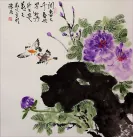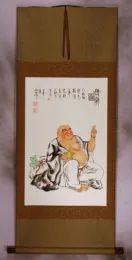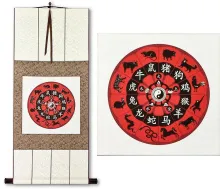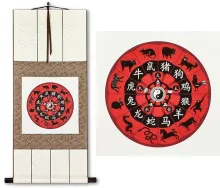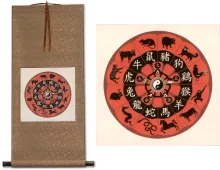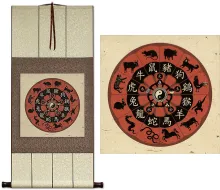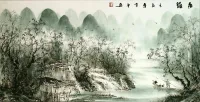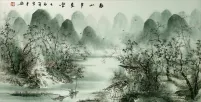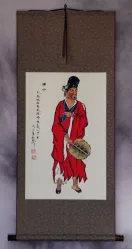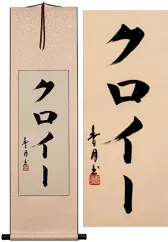Many custom options...
And formats...

Not what you want?
Try other similar-meaning words, fewer words, or just one word.
Feel free to email me with your request. If it's easy, I'll translate it for free and add it to this database of calligraphy for you.
All Seeing in Chinese / Japanese...
Buy an All Seeing calligraphy wall scroll here!
Brahmavihara - The Four Immeasurables
四無量心 is the cattāri brahmavihārā or catvāri apramāṇāni.
The four immeasurables, or infinite Buddha-states of mind. These four dhyānas include:
1. 慈無量心 boundless kindness, maitrī, or bestowing of joy or happiness.
2. 悲無量心 boundless pity, karuṇā, to save from suffering.
3. 喜無量心 boundless joy, muditā, on seeing others rescued from suffering.
4. 捨無量心 limitless indifference, upekṣā, i.e., rising above these emotions or giving up all things.
This in-stock artwork might be what you are looking for, and ships right away...
Gallery Price: $286.00
Your Price: $158.88
Gallery Price: $300.00
Your Price: $109.88
Huge Chinese Boat River Village Landscape Painting
Discounted Blemished
Gallery Price: $89.00
Your Price: $49.00
Gallery Price: $100.00
Your Price: $49.77
Gallery Price: $107.00
Your Price: $59.00
Gallery Price: $72.00
Your Price: $39.88
Not the results for all seeing that you were looking for?
Below are some entries from our dictionary that may match your all seeing search...
| Characters If shown, 2nd row is Simp. Chinese |
Pronunciation Romanization |
Simple Dictionary Definition |
一 see styles |
yī yi1 i ii / i イー |
More info & calligraphy: One(numeric) one (chi: yī); (female given name) Moto eka. One, unity, monad, once, the same; immediately on (seeing, hearing, etc.). |
四無量心 四无量心 see styles |
sì wú liàng xīn si4 wu2 liang4 xin1 ssu wu liang hsin shi muryōshin |
More info & calligraphy: Brahmavihara - The Four Immeasurables |
以上 see styles |
yǐ shàng yi3 shang4 i shang ijō いじょう |
that level or higher; that amount or more; the above-mentioned; (used to indicate that one has completed one's remarks) That is all. (n-adv,n-t) (1) not less than; ... and more; ... and upwards; (2) beyond ... (e.g. one's means); further (e.g. nothing further to say); more than ... (e.g. cannot pay more than that); (3) above-mentioned; foregoing; (4) since ...; seeing that ...; (5) this is all; that is the end; the end ...and above |
八識 八识 see styles |
bā shì ba1 shi4 pa shih hasshiki; hachishiki はっしき; はちしき |
{Buddh} eight consciousnesses (one for each of the five senses, consciousness of the mind, self-consciousness and store consciousness) The eight parijñāna, or kinds of cognition, perception, or consciousness. They are the five senses of cakṣur-vijñāna, śrotra-v., ghrāna-v., jihvā-v., and kāya-v., i.e. seeing, hearing, smelling, tasting, and touch. The sixth is mano-vijñāna, the mental sense, or intellect, v. 末那. It is defined as 意 mentality, apprehension, or by some as will. The seventh is styled kliṣṭa-mano-vijñāna 末那識 discriminated from the last as 思量 pondering, calculating; it is the discriminating and constructive sense, more than the intellectually perceptive; as infected by the ālaya-vijñāna., or receiving "seeds" from it, it is considered as the cause of all egoism and individualizing, i.e. of men and things, therefore of all illusion arising from assuming the seeming as the real. The eighth is the ālaya-vijñāna, 阿頼耶識 which is the storehouse, or basis from which come all "seeds"of consciousness. The seventh is also defined as the ādāna 阿陀那識 or "laying hold of" or "holding on to" consciousness. |
十地 see styles |
shí dì shi2 di4 shih ti juuji / juji じゅうじ |
{Buddh} dasabhumi (forty-first to fiftieth stages in the development of a bodhisattva); (place-name) Jūji daśabhūmi; v. 十住. The "ten stages" in the fifty-two sections of the development of a bodhisattva into a Buddha. After completing the十四向 he proceeds to the 十地. There are several groups. I. The ten stages common to the Three Vehicles 三乘 are: (1) 乾慧地 dry wisdom stage, i. e. unfertilized by Buddha-truth, worldly wisdom; (2) 性地 the embryo-stage of the nature of Buddha-truth, the 四善根; (3) 八人地 (八忍地), the stage of the eight patient endurances; (4) 見地 of freedom from wrong views; (5) 薄地 of freedom from the first six of the nine delusions in practice; (6) 離欲地 of freedom from the remaining three; (7) 巳辨地 complete discrimination in regard to wrong views and thoughts, the stage of an arhat; (8) 辟支佛地 pratyeka-buddhahood, only the dead ashes of the past left to sift; (9) 菩薩地 bodhisattvahood; (10) 佛地 Buddhahood. v. 智度論 78. II. 大乘菩薩十地 The ten stages of Mahāyāna bodhisattva development are: (1) 歡喜地 Pramuditā, joy at having overcome the former difficulties and now entering on the path to Buddhahood; (2) 離垢地 Vimalā, freedom from all possible defilement, the stage of purity; (3) 發光地 Prabhākarī, stage of further enlightenment; (4) 焰慧地 Arciṣmatī, of glowing wisdom; (5) 極難勝地 Sudurjayā, mastery of utmost or final difficulties; (6) 現前地 Abhimukhī, the open way of wisdom above definitions of impurity and purity; (7) 遠行地 Dūraṁgamā, proceeding afar, getting above ideas of self in order to save others; (8) 不動地 Acalā, attainment of calm unperturbedness; (9) 善慧地 Sādhumatī, of the finest discriminatory wisdom, knowing where and how to save, and possessed of the 十力 ten powers; (10) 法雲地 Dharmamegha, attaining to the fertilizing powers of the law-cloud. Each of the ten stages is connected with each of the ten pāramitās, v. 波. Each of the 四乘 or four vehicles has a division of ten. III. The 聲聞乘十地 ten Śrāvaka stages are: (1) 受三歸地 initiation as a disciple by receiving the three refuges, in the Buddha, Dharma, and Saṅgha; (2) 信地 belief, or the faith-root; (3) 信法地 belief in the four truths; (4) 内凡夫地 ordinary disciples who observe the 五停心觀, etc.; (5) 學信戒 those who pursue the 三學 three studies; (6) 八人忍地 the stage of 見道 seeing the true Way; (7) 須陀洹地 śrota-āpanna, now definitely in the stream and assured of nirvāṇa; (8) 斯陀含地 sakrdāgāmin, only one more rebirth; (9) 阿那含地 anāgāmin, no rebirth; and (10) 阿羅漢地 arhatship. IV. The ten stages of the pratyekabuddha 緣覺乘十地 are (1) perfect asceticism; (2) mastery of the twelve links of causation; (3) of the four noble truths; (4) of the deeper knowledge; (5) of the eightfold noble path; (6) of the three realms 三法界; (7) of the nirvāṇa state; (8) of the six supernatural powers; (9) arrival at the intuitive stage; (10) mastery of the remaining influence of former habits. V. 佛乘十地 The ten stages, or characteristics of a Buddha, are those of the sovereign or perfect attainment of wisdom, exposition, discrimination, māra-subjugation, suppression of evil, the six transcendent faculties, manifestation of all bodhisattva enlightenment, powers of prediction, of adaptability, of powers to reveal the bodhisattva Truth. VI. The Shingon has its own elaborate ten stages, and also a group 十地十心, see 十心; and there are other groups. |
已上 see styles |
yǐ shàng yi3 shang4 i shang ijō いじょう |
(n-adv,n-t) (1) not less than; ... and more; ... and upwards; (2) beyond ... (e.g. one's means); further (e.g. nothing further to say); more than ... (e.g. cannot pay more than that); (3) above-mentioned; foregoing; (4) since ...; seeing that ...; (5) this is all; that is the end; the end ...and above |
慧眼 see styles |
huì yǎn hui4 yan3 hui yen keigan / kegan けいがん |
an all-seeing mind; mental perception; insight; acumen (noun or adjectival noun) keen eye; quick eye; sharp eye; keen insight; keen perception The wisdom-eye that sees all things as unreal. |
空諦 空谛 see styles |
kōng dì kong1 di4 k`ung ti kung ti kuutai / kutai くうたい |
{Buddh} (See 三諦) truth of emptiness (holding that all things are void) The doctrine of immateriality, one of the three dogmas of Tiantai, that all things animate and inanimate, seeing that they result from previous causes and are without reality in themselves, are therefore 空or not material, but "spiritual". |
通惑 see styles |
tōng huò tong1 huo4 t`ung huo tung huo tsūwaku |
The two all-pervading deluders見 and 思 seeing and thinking wrongly i.e. taking appearance for reality. |
三念住 see styles |
sān niàn zhù san1 nian4 zhu4 san nien chu san nenjū |
(or 三念處). Whether all creatures believe, do not believe, or part believe and part do not believe, the Buddha neither rejoices, nor grieves, but rests in his proper mind and wisdom, i.e. though full of pity, his far-seeing wisdom 正念正智 keeps him above the disturbances of joy and sorrow. 倶舍論 27. |
四住地 see styles |
sì zhù dì si4 zhu4 di4 ssu chu ti shi jūji |
(四住) The four states or conditions found in mortality; wherein are the delusions of misleading views and desires. They are (1) 見一切住地 the delusions arising from seeing things as they seem, not as they really are. (2) 欲愛住地 the desires in the desire-realm. (3) 色愛住地 the desires in the form-realm. (4) 有愛住地 the desires in the formless realm. When 無明住地 the state of ignorance is added we have the 五住地 five states. These five states condition all error, and are the ground in which spring the roots of the countless passions and delusions of all mortal beings. |
豁然大悟 see styles |
katsuzentaigo かつぜんたいご |
(noun/participle) (yoji) suddenly seeing the light; achieving full enlightenment all of a sudden |
西方廣目天王 西方广目天王 see styles |
xī fāng guǎng mù tiān wáng xi1 fang1 guang3 mu4 tian1 wang2 hsi fang kuang mu t`ien wang hsi fang kuang mu tien wang Saihō Kōmoku Tennō |
Deva King All Seeing, of the West |
Variations: |
ijou / ijo いじょう |
(n,adv) (1) not less than; ... and over; ... and above; ... and upwards; ... or more; (n,adv) (2) beyond (e.g. one's expectations); above; more than; further than; (adj-no,n,adv) (3) above-mentioned; aforementioned; foregoing; (n,adv) (4) since ...; seeing that ...; now that ...; once ...; (expression) (5) that's all; that is the end; the end |
Variations: |
ijou / ijo いじょう |
(suffix noun) (1) (ant: 以下・1) not less than ...; ... and over; ... and above; ... and upwards; ... or more; (suffix noun) (2) beyond (e.g. one's expectations); above; more than; further than; (adj-no,n) (3) the above; the above-mentioned; the aforementioned; the foregoing; (n,conj) (4) (after a verb) since ...; seeing that ...; now that ...; once ...; (expression) (5) that's all; that is the end; the end |
The following table may be helpful for those studying Chinese or Japanese...
| Title | Characters | Romaji (Romanized Japanese) | Various forms of Romanized Chinese | |
| Brahmavihara - The Four Immeasurables | 四無量心 四无量心 | shi mur you shin shimuryoushin shi mur yo shin | sì wú liàng xīn si4 wu2 liang4 xin1 si wu liang xin siwuliangxin | ssu wu liang hsin ssuwulianghsin |
| In some entries above you will see that characters have different versions above and below a line. In these cases, the characters above the line are Traditional Chinese, while the ones below are Simplified Chinese. | ||||
Successful Chinese Character and Japanese Kanji calligraphy searches within the last few hours...

